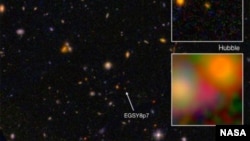Astronomers say they may have glimpsed the most distant galaxy ever spotted, something conventional theories about the early universe say should not have been possible.
The galaxy, called EGS8p7, is believed to be 13.2 billion years old, meaning it formed shortly after the Big Bang when the universe was “a soup of charged particles” from which light could not be transmitted.
In the early universe, “clouds of neutral hydrogen atoms would have absorbed certain radiation emitted by young, newly forming galaxies,” according to a news release from California Institute of Technology, or Caltech. This would include the spectral signature of hot hydrogen gas, known as the Lyman-alpha line, which is a sign of new star formation.
Scientists believe it was not until around 380,000 years before light was able to transverse the cosmos, and between one half billion and one billion years before the first galaxies “turned on” and reionized neutral gases, but EGS8p7 may change that theory.
Yet, despite the theories about light absorption, astronomers were able to use redshift measurements to determine EGS8p7’s distance. Light stretches and becomes redder the further it travels, and redshift measurements are a common way to measure the distance to galaxies.
Adi Zitrin, a NASA Hubble postdoctoral scholar in astronomy at Caltech, says EGS8p7 may cause scientists to “revise the timeline” for galaxy formation in the early universe.
"If you look at the galaxies in the early universe, there is a lot of neutral hydrogen that is not transparent to this emission," said Zitrin in a statement. "We expect that most of the radiation from this galaxy would be absorbed by the hydrogen in the intervening space. Yet still, we see Lyman-alpha from this galaxy."
The timeline of reionization is, according to Zitrin, a “major key question” surrounding the early universe, and EGS8p7 may show it did not happen uniformly around the universe.
"The galaxy we have observed, EGS8p7, which is unusually luminous, may be powered by a population of unusually hot stars, and it may have special properties that enabled it to create a large bubble of ionized hydrogen much earlier than is possible for more typical galaxies at these times," says Sirio Belli, a Caltech graduate student who worked on the project.
Astronomers Spot 'Most Distant Galaxy'
- By VOA News







